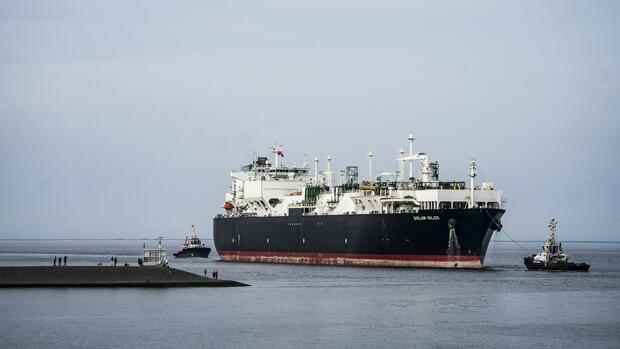Paris The French company Gaztransport & Technigaz (GTT) is known primarily to energy insiders. The company dominates a niche that has been central to Europe’s energy supply since Russian gas supplies dried up: GTT is the undisputed market leader in the technology for the cold tanks that ships use to transport liquefied natural gas (LNG).
Business is booming: in 2022, “all previous sales records were broken,” said GTT boss Philippe Berterottière. In the first nine months of the year, the company recorded 134 orders for the equipment of tanker ships, and in the third quarter alone 46 orders were added.
The demand for new LNG tankers is great, but the capacities of GTT and its partner shipyards in South Korea and China are limited. The ships that are now on the order books will only be launched between the second half of 2024 and the second half of 2027.
Regardless of the question of how quickly the global liquid gas fleet will be expanded at all, one thing is certain: the transport solutions of the French play a decisive role. “GTT’s market share is approaching 100 percent,” says Guillaume Delaby, an energy analyst at major French bank Société Générale.
Top jobs of the day
Find the best jobs now and
be notified by email.
According to the market research company ICIS, around 650 large LNG tankers are currently in use on the world’s oceans. By 2027, this number will increase by 229 ships, so the liquid gas fleet will grow by around a third.
After a period of low gas prices, there was a slump in orders in the LNG tanker market at the end of the last decade, says ICIS expert Rob Songer. The corona crisis then further depressed demand for the special ships.
Then Russia attacked Ukraine and cut off gas supplies to Europe. “LNG was the only way for Europe to increase gas flows quickly to compensate for the volume lost from Russia,” Songer said.
>> Read here: LNG tankers stopped – gas traders are waiting for a better gas price
The majority of all LNG tankers are built at four shipyards in South Korea, which according to ICIS currently have an order backlog of around 200 ships to process. Chinese shipbuilders are also becoming increasingly important. And all of them require GTT tank technology.
After natural gas is liquefied by cooling it to minus 160 degrees Celsius, it has to be transported under these extremely low temperature conditions. For a long time, shipowners have relied on spherical cryogenic tanks from the Norwegian company Moss, which protrude visibly from the ship’s deck.
“Since the 1990s, GTT has gained more and more market share with its technology,” says Société Générale analyst Delaby. The French company’s so-called membrane tanks can be adapted to the shape of the ship, enabling more efficient transport of large quantities of LNG. They are lighter and cheaper – and have established themselves on the market.
Shipowners rely on technology from GTT
Delaby doesn’t expect the French quasi-monopoly to change anytime soon. “It is true that competing technologies have been developed,” he says. However, the industry is very conservative because LNG is a very dangerous, explosive cargo.
“Shipowners don’t want to take the risk of using anything other than GTT’s proven reliable technology just to save maybe a few hundred thousand euros,” says the Société Générale analyst. In addition, the company continues to develop the tank design: “In 2014 GTT held 500 patents, now there are 2281.”
>> Read also: More and more LNG tankers are damming up off the coast – because Europe’s gas market is not working
The French act as a kind of engineering office: GTT develops the LNG tanks, but does not build them itself. “The business model consists of the company receiving license fees for its technology,” explains Delaby.
GTT also sends its experts to the partner shipyards to advise them on the construction of the tankers. “Our mission goes far beyond serving the growing demand,” says GTT boss Berterottière of the Handelsblatt.
“We help our customers to find answers to new regulatory challenges and support them in decarbonization.” This also includes the development of software solutions that send tankers on the most cost-effective and environmentally friendly route. “Our ambition is to become a leading player in digital services.”
Demand for production in Europe
According to GTT, it has 535 employees, many of whom work in research and development. The company is highly profitable: GTT is aiming for sales of between 290 and 320 million euros in 2022. Earnings before interest, taxes, depreciation and amortization should be between 140 and 170 million euros this year.
Berterottière expects demand for LNG to increase, and not just in Europe. “The traditional importers of liquid gas such as China and Japan are also contributing to the demand.” In the future, the ships will also increasingly transport liquid hydrogen instead of LNG.
>> Read here: What you need to know about the gas and electricity price brake
The GTT boss demands that the construction of new ships must therefore be accelerated. “Currently, the capacities of the shipyards are 65 to 70 LNG tankers per year.” An increase to 80 to 85 tankers is necessary in the coming years.
Berterottière calls on the Europeans not to leave production to shipyards in Asia alone. “In view of energy independence and the strategic role of LNG carriers, Europe should seriously consider relocating this business field to its territory.”
More: All-clear or false security: how likely is the gas emergency?
